Lighthouse Tours By Boat
Taking a lighthouse tour on the Chesapeake Bay with your boat rental from South River Boat Rental can be an incredibly fun and enlightening experience. As you cruise down the South River and head towards iconic lighthouses like the Thomas Point Shoal Lighthouse, you’ll not only enjoy the stunning views and picturesque landscapes, but you’ll also learn about the rich history and significance of these historic beacons.
With the opportunity to capture great photos of the lighthouses and the surroundings, a lighthouse tour on the Chesapeake Bay is a unique and memorable way to explore the region’s maritime heritage. So, grab your friends or family, rent a boat from South River Boat Rental, and embark on an adventure that combines relaxation, education, and a touch of maritime magic.
Chesapeake Bay Lighthouses
Chesapeake Bay, known for its rich maritime history and picturesque coastlines, is dotted with an array of historical lighthouses. These beacons have guided mariners for generations through the Bay’s intricate network of rivers and shipping channels. A tour around Chesapeake Bay’s lighthouses offers a voyage through time, spotlighting the architectural marvels and the tales that surround them.

Importance of Lighthouses in Chesapeake Bay
The lighthouses perched along Chesapeake Bay’s rugged shorelines are far more than mere points of interest; they are pillars of the region’s history and culture. They have provided critical navigation aids—warnings of shallow waters, and precise channel locations—and acted as beacons of security for those traversing the expansive waters.
Each lighthouse, distinct in design and steeped in history, portrays a chapter of America’s maritime evolution, from the age of sail to the era of steam. The continued fascination with these timeless structures invites explorers to venture through the Bay’s scenic landscapes and experience the enduring legacy of the lighthouses that have long safeguarded its waters. Today, over two dozen lighthouses remain in Maryland, with many actively serving nautical travelers, while others beckon visitors to tour these historical beacons and enjoy the natural beauty and sweeping views of this iconic American estuary.
Historic Lighthouses in Chesapeake Bay
The Old Cape Henry Lighthouse, crafted in 1792, holds the title of the oldest lighthouse on the Chesapeake Bay and is the third oldest still standing in the United States, a true testament to the navigational history of the area.
As maritime traffic and technology evolved, so did the designs of these coastal sentinels. For example, the Sandy Point Shoal Lighthouse, originally constructed as a shore light in 1858 and electrified in 1929, embodies the advances in lighting technology. Meanwhile, the Hooper Strait Lighthouse, erected in 1879, stands as one of the last four remaining Chesapeake Bay lighthouses designed with the iconic screw-pile style, evoking images of a bygone era of maritime engineering.
The Greenbury Point Lighthouse, though no longer standing, was once a guiding light at the mouth of the Severn River, first lit in 1848 and later replaced by the Greenbury Point Shoal Lighthouse after its deactivation in 1891. These historic lighthouses are more than just aids to navigation; they are symbols of the Chesapeake Bay’s enduring legacy as a hub of maritime activity, and they continue to captivate both locals and visitors with their stories and panoramic views.
From the revolutionary to the Victorian era, the Chesapeake Bay has remained safeguarded by these beacons. Today, these structures offer a glimpse into the past, where lighthouse keepers would diligently work to ensure the safety of passing ships. They now stand as majestic landmarks and a testament to the Bay’s rich maritime heritage.
Concord Point Lighthouse
Concord Point Lighthouse, commanding attention with its 30-foot port deposit granite structure, serves as a beacon of Maryland’s lighthouse history. Master builder John Donahoo constructed this durable edifice, which has weathered storms and time since its illumination in 1827. Strategically positioned at the confluence of the Susquehanna River and Chesapeake Bay, the lighthouse’s gleam has long been a critical warning of the challenging waters below.
Today, the lighthouse and its Keepers House Museum are open to the public, inviting them to climb the tower and immerse themselves in the centuries-old narrative of maritime navigation. Sitting at Lafayette and Concord Street in Havre de Grace, the Concord Point Lighthouse is not only a historic monument; it serves as a hub of community and special events. Open Saturdays and Sundays from 1-5 pm between April and October, each visit to this venerable structure is a step back in time.
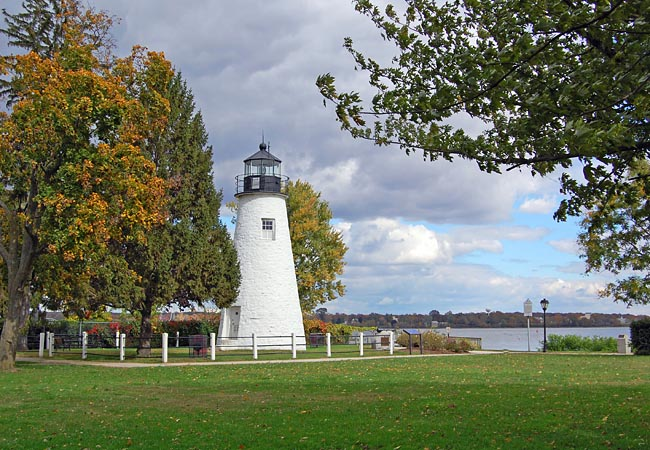
Thomas Point Shoal Lighthouse
The iconic Thomas Point Shoal Lighthouse stands as a lasting tribute to Chesapeake Bay’s maritime heritage. Erected in 1875, this screwpile lighthouse is the last of its kind in its original location, fiercely persevering against time and the elements. Visitors seeking to witness this historical marvel must travel by boat, guided by volunteer docents eager to share the lighthouse’s storied past.
Designated as a National Register Historic Place, Thomas Point Shoal’s history is striking, having witnessed British ships, commanded by Admiral George Cockburn, becoming ensnared on the shoal during the War of 1812. Located just south of Annapolis, it bore witness to maritime history’s unfolding, standing guard until it was the last manned light on Chesapeake Bay, replaced by automated systems in 1964.

Sandy Point Shoal Lighthouse
Standing sentinel in the shallow waters near Anne Arundel County, the Sandy Point Shoal Lighthouse is an emblematic structure of Chesapeake Bay’s rich navigational heritage. Dating back to 1883, with its distinctive eight-sided, red brick tower, this lighthouse replaced an earlier beacon to better serve the maritime community navigating the northern end of the Chesapeake Bay Bridge.
Managed by the U.S. Coast Guard, and a fixture of the region since its electrification in 1929, Sandy Point Shoal Lighthouse was automated in the 1960s to adapt to modern navigational needs. Visible from the nearby Sandy Point State Park, this historically significant lighthouse continues to attract countless visitors each year, drawn by its unique architecture and historical significance.
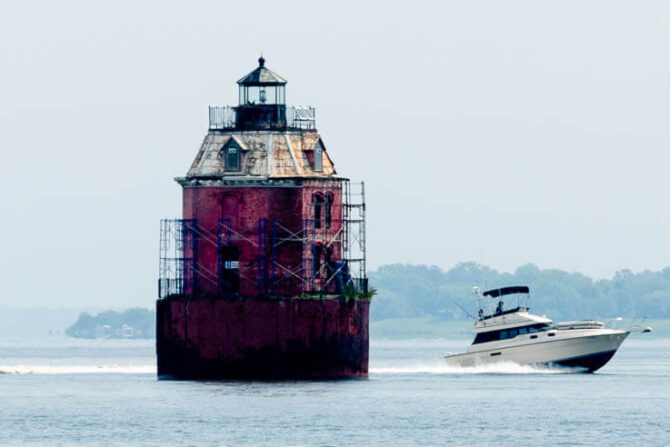
Hooper Strait Lighthouse
Originally marking the entrance to Tangier Sound, the Hooper Strait Lighthouse is a storied structure that has escaped the fate of many of its contemporaries. When the Coast Guard decided to dismantle the obsolete screw-pile lights in the 1960s, the Hooper Strait Lighthouse was carefully deconstructed and reassembled on dry land in St. Michaels, saving it from certain destruction.
Now a proud exhibit at the Chesapeake Bay Maritime Museum, the lighthouse is part of the collective effort to preserve these iconic structures. As one of the last four remaining screw-pile style lighthouses in the Chesapeake Bay, the Hooper Strait Lighthouse offers visitors interactive experiences and historical display, keeping maritime history alive for new generations.
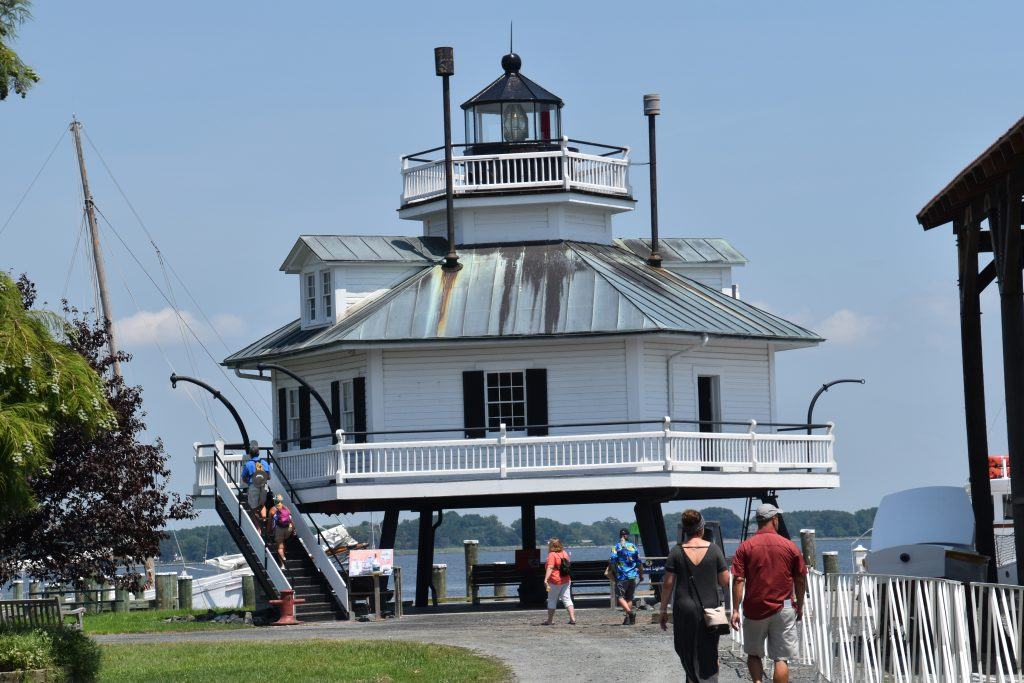
Lazaretto Point Lighthouse
Situated at Baltimore Light Station, Lazaretto Point Lighthouse marks its place in Chesapeake Bay’s landscape with historical significance and technological milestones. First shining its light in 1908 and later automated in 1923, the lighthouse once received the world’s attention by becoming the first to be nuclear-powered in 1964, an atomic generator lighting the way.
After the removal of the nuclear source and sale by the U.S. Coast Guard to private owners in 2006, the Lazaretto Point Lighthouse remains an important part of Maryland’s lighthouse history. Now harnessing the power of the sun, the lighthouse continues to stand as a testament to the Bay’s importance as a shipping channel and as a symbol of historic preservation and innovation.

Haunted Lighthouses in Chesapeake Bay
The haunting beauty of Chesapeake Bay is perfectly encapsulated in its historic lighthouses, many of which offer much more than their storied pasts. They are shrouded in ghostly tales that add an extra layer of allure to these maritime relics. From Cove Point to the spectral shores of Drum Point, these lighthouses provide intriguing tales for the brave and curious. Cove Point, with its original keeper’s quarters available for rent, offers visitors a unique immersive experience, perhaps even a spectral encounter. Drum Point Lighthouse, located at the Calvert Marine Museum, not only invites guests to explore its innkeeper’s quarters but also to delve into its ghostly folklore.
Ghostly Legends and Stories of Chesapeake Bay Lighthouses
Each of these historical structures has its own set of eerie legends. The Cove Point Lighthouse, a beacon first established in 1828, stands as a timeless guardian over the bay. Its quarters, once home to lighthouse keepers and their families, are said to echo with the ethereal footsteps of the past. The Drum Point Lighthouse, with its hexagonal screwpile design, beams not just light across the waters, but also tales of apparitions seen within its walls.
But none so iconic as the Thomas Point Shoal Lighthouse, its solitary presence in the open waters serving as a catalyst for chilling lore. Public tours give life to the stories of its keepers, recounting sightings of ghosts and unexplained phenomena that have sparked the interest of both history enthusiasts and ghost hunters alike. These tales are woven into the fabric of Maryland’s coastal narrative, making the Chesapeake Bay’s lighthouses a destination for those who appreciate the paranormal as much as maritime history.
Paranormal Investigations at Lighthouses in Chesapeake Bay
The mystery surrounding Chesapeake Bay’s beacons of light extends into the realm of the supernatural. Paranormal investigations are becoming increasingly popular, as enthusiasts seek to uncover the truth behind the spectral sightings at these historic sites. Locations like Cove Point and Drum Point, with their open tours and keeper’s quarters’ rentals, set the stage for those eager to connect with the otherworldly.
However, the Thomas Point Shoal Lighthouse, accessible by boat and teeming with history, stands out as a prime hotspot for paranormal activity. Inviting those with a taste for adventure and the unexplained, these investigations blend scientific inquiry with the allure of nautical legend, casting these lighthouses not only as essential navigational instruments but as vaults of supernatural secrets as well. Whether visitors come driven by a fascination with ghosts or a passion for heritage conservation, Maryland’s haunted lighthouses are an extraordinary link to the Chesapeake Bay’s enigmatic past.
Tallest Lighthouse in Chesapeake Bay
Cape Charles Light: A Towering Beacon of Chesapeake Bay
Tower above the rest, the Cape Charles Lighthouse on Smith Island earns the title of being the tallest lighthouse in Chesapeake Bay and Virginia while proudly standing as the second tallest across the United States. Soaring into the sky at a staggering height of 191 feet, this impressive structure has been a crucial maritime guide since 1895. Visitors crossing the Chesapeake Bay Bridge-Tunnel may catch a glimpse of its towering frame, a stoic sentinel over the bay’s shifting shoals and bustling shipping channels.
Despite its grandeur and significant heritage, the Cape Charles Light retains a shroud of exclusivity as it is not open for public tours. Owned by the U.S. Coast Guard, this beacon remains off-limits, yet it never ceases to fascinate and inspire those who marvel at it from a distance. Its size and historical importance make it a must-see landmark on any Chesapeake Bay lighthouse itinerary, even if it’s just from the bridge or from afar.
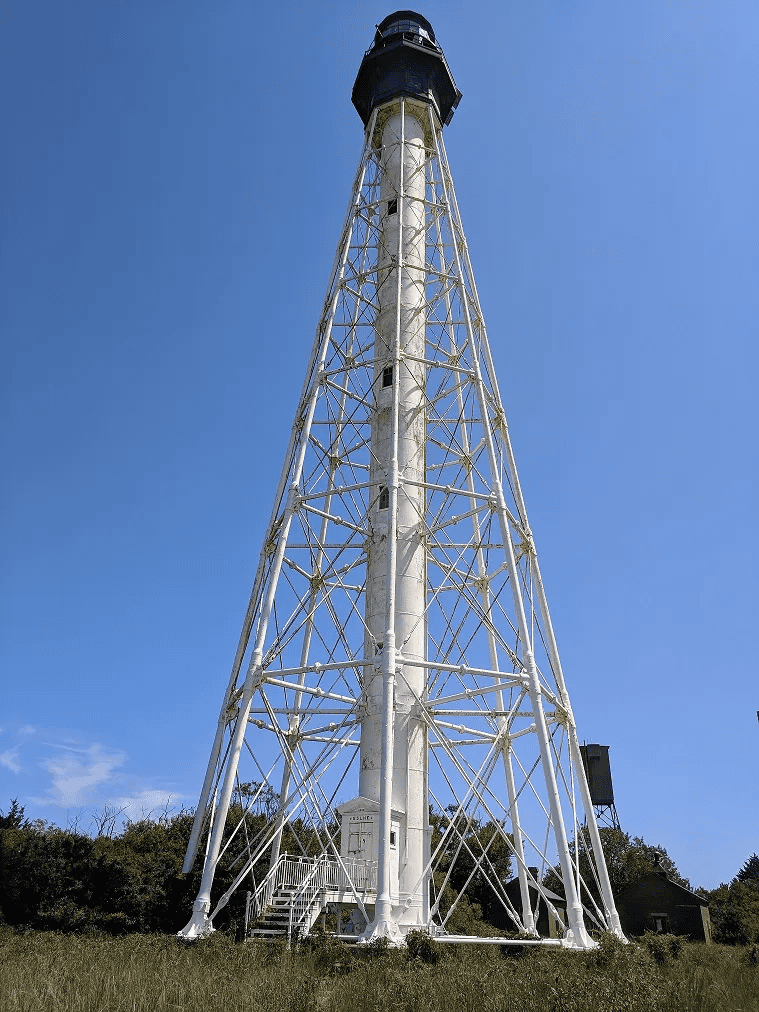
Lighthouses on the Potomac, Severn, and Susquehanna Rivers
The waterways of the Potomac, Severn, and Susquehanna Rivers in the Chesapeake Bay region are marked by historical lighthouses, each with its own tale and charm. The lighthouses along these rivers not only offered navigational guidance but also served as waypoints for pivotal moments in history, such as aiding freedom seekers on the Underground Railroad.
List of Lighthouses on the Potomac, Severn, and Susquehanna Rivers
Cove Point Lighthouse
- Built in 1828 by renowned lighthouse architect John Donohoo.
- Oldest continuously operating lighthouse in Maryland.
- Serves the entrance to the Patuxent River.
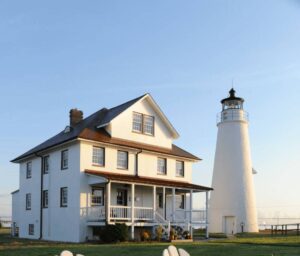
Pooles Island Light
- Completed in 1825, holds the title of the oldest remaining lighthouse in Maryland.
- Inactive since 1939 but stands as a historical icon.
Drum Point Lighthouse
- Displayed at the Calvert Marine Museum.
- Open to the public year-round.
- Provides insight into the life of a lighthouse keeper.
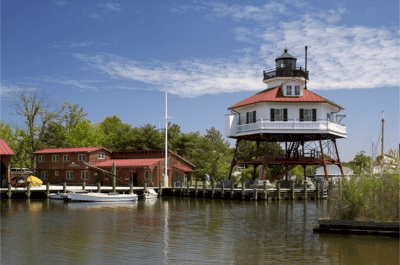
Fishing Battery Lighthouse
- Originally constructed in 1853.
- Situated near Havre de Grace.
- Had plans to be converted into a bed-and-breakfast.
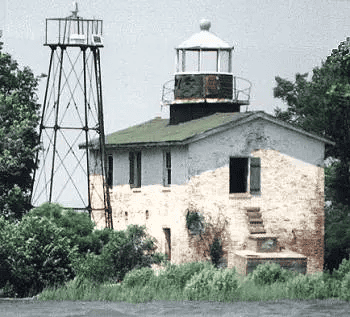
Seven-Foot Knoll Lighthouse
- First lit in 1855 at the mouth of the Patapsco River, Anne Arundel County.
- It was the oldest screw-pile lighthouse in Maryland.
- Moved to Baltimore’s Inner Harbor as a museum piece.

These lighthouses, many of which have transitioned to unmanned operations to meet modern navigational demands, represent a rich tapestry of maritime heritage that is synonymous with the story of Chesapeake Bay and its tributaries. Visitors to the region are drawn not only to the enchanting coastal views but also to the deep historical significance embodied by these time-honored beacons.
Forts and Lighthouses in Chesapeake Bay
Travelers and maritime history aficionados alike can set their sights on a collection of storied beacons that punctuate the coastal landscape of Chesapeake Bay. Notable among them, the Thomas Point Shoal Lighthouse not only captivates with its iconic design but holds the distinction of being the last screw-pile lighthouse in its original location in the bay. The Sharps Island Lighthouse, battling the elements, leans markedly due to ice floe impacts over the years, and the Sandy Point Shoal Lighthouse, conveniently visible from the bustling Chesapeake Bay Bridge, stands guard near the shores.
Further into the bay, the Wolf Trap Light, a testament to resilience and engineering, was established in 1870 near the Rappahannock River to replace former lightships and has been marking the menacing shoals with its 52-foot-tall presence since its reconstruction in 1894. Farther still, at the very entry to the Chesapeake, you will find the Chesapeake Light Station, a marvel of mid-20th-century engineering with its Texas tower design, evocative of an offshore oil platform and reachable only by helicopter.
A visit to the Hooper Strait Lighthouse, dating back to 1879, offers more than a visual feast. It is an educational journey with hands-on activities and exhibits illustrating the bountiful history of the bay. For those enchanted by the life of solitude and vigilance led by a lighthouse keeper, the opportunity to stay overnight in the keeper’s quarters is one not to be missed.
The Sandy Point Shoal Lighthouse near Annapolis holds the honor of being the last manned light of the bay, symbolizing the era of vigilance over these waters. Meanwhile, the Chesapeake Light Station’s historic significance, with intricate tales of maritime guidance and survival, continues to linger in the salty air long after its automation and discontinuation of manned operations.
Historical Significance of Lighthouses in Relation to Forts in Chesapeake Bay
The expanses of water in Chesapeake Bay have seen more than their fair share of history, and the lighthouses that dot the shoreline have long played a pivotal role alongside the forts that watched over these storied waters. Lighthouses like the venerable Turkey Point Lighthouse, erected in 1833 with its stark yet beautiful contrast of black and white, have served as foundational aids to navigation. This network of lights and beacons has been as critical to the safe passage of ships as the forts that once stood as bastions of defense, with their canons pointed outward to protect and to project power.
Together, these lighthouses and forts have stood as stalwart guides and guardians, each in its own way illuminating paths and protecting shores. They have defined channels, warned of shallows, and marked locations, becoming emotional landmarks that echo the heartbeat of the nation’s history. The stories they hold are as layered as the sediment that lines the bay’s floor, from their role in guiding troops during wars to their silent vigilance in times of peace.
Thomas Point Shoal Lighthouse represents such a blend of beauty and history that draws spectators and history buffs alive to its graceful form. Throughout Maryland, with a tally of over two dozen lighthouses, many still in active service, these monuments of maritime safety that once directed sailors away from peril now capture the imagination of visitors with their enduring charm and fascinating past. Each light, with its unique character and story, continues to reflect a piece of the maritime soul and heritage of Chesapeake Bay.
Modern Amenities and Attractions at Chesapeake Bay Lighthouses
Chesapeake Bay, with its robust maritime heritage, offers a contemporary twist on the traditional lighthouse experience. Many of these historic beacons have embraced modernity, providing visitors with comfortable amenities and interactive attractions. From vacation rentals to museum exhibits, the lighthouses around the bay have been thoughtfully re-purposed to welcome a new generation of enthusiasts.
Highlights of Modern Amenities and Activities at Select Lighthouses
Cove Point Lighthouse: A beacon of light in more ways than one, Cove Point stands out with its offer of a truly immersive experience. Travelers can relish the unique opportunity to live like a lighthouse keeper, with two meticulously renovated rental units available in the keepers’ quarters. Accommodating up to 16 guests, these units blend historical ambiance with contemporary comforts, including modern amenities and exclusive beach access. This not only provides a serene getaway but allows guests to intimately connect with the history they are surrounded by.
Drum Point Lighthouse: Nestled within the Calvert Marine Museum, Drum Point Lighthouse captures the essence of a bygone era with a twist of modern engagement. Visitors can ascend the 46-foot-tall hexagonal wooden structure, which rests charmingly on a wrought-iron screwpile base, and stroll through the restored innkeeper’s quarters. Adding to this cultural excursion, tourists have the option of embarking on boat tours that grant a waterside perspective of neighboring lighthouses, harmonizing history with aquatic adventure. Despite its historical allure, Drum Point remains an active aid to navigation, dutifully maintained by the U.S. Coast Guard, providing a tangible link between the past and present navigational needs.
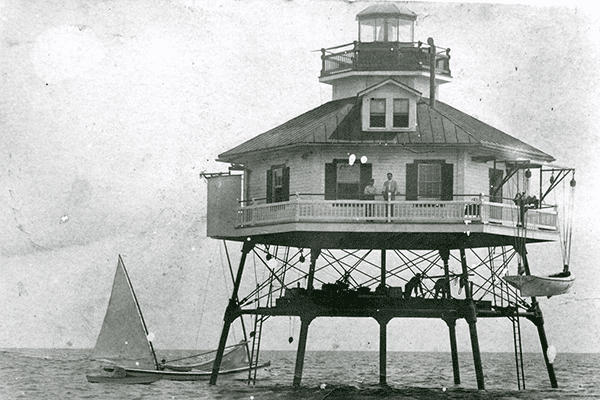
Point Lookout Lighthouse: At the confluence of the Potomac River and Chesapeake Bay, Point Lookout Lighthouse is steeped in Civil War heritage. Built in 1830 by renowned lighthouse builder John Donohoo, it offered solace to Union soldiers as a hospital during the conflict. Today, this poignant landmark allows visitors to delve into its rich narrative while exploring the site, which has been aptly sustained to reflect its historical significance through the years.
Fort Washington Lighthouse: Operated by the National Park Service since 2005, this timeless structure stands sentinel in a blend of antiquity and modern tourism. Fort Washington Lighthouse not only offers historical insight but also plays host to various tours and events, drawing visitors to explore the grounds and learn about its enduring role in maritime safety.
By repurposing these historic structures to incorporate modern amenities and activities, the lighthouses of Chesapeake Bay have become more accessible and engaging for the public. They enchant visitors with stories of maritime bravery while providing contemporary convenience, ensuring that their legacy continues to shine brightly.
Preservation and Restoration Efforts of Chesapeake Bay Lighthouses
Chesapeake Bay’s lighthouses are more than navigational aids; they represent pivotal moments in the narrative of American history. Their lights have long been safeguarding mariners and fishermen from the potentially treacherous waters fringing the bay. It is thanks to the revenue generated from lighthouse tours and cruises that we can maintain these emotive benchmarks. These experiences not only enrich the knowledge of visitors but also secure the financial support needed to continue crucial preservation work on these historical maritime sentinels.
In concert with these conservation initiatives, volunteer efforts significantly fuel the restoration and care of the region’s lighthouses. Societies and enthusiasts contribute time and expertise to ensure that each beacon not only remains structurally sound but also retains its historical integrity. Teams from organizations like the U.S. Lighthouse Society are passionate custodians of the lighthouse legacy, dedicated to preserving the stories these towers tell.
The availability of public tours is a testament to the extensive restoration work that has been carried out, allowing individuals from all walks of life to step inside these living museums. Each visit supports the ongoing efforts to maintain lighthouses as artifacts of nautical history. Furthermore, wandering through the hallways of coastal guardians like the Hooper Strait Lighthouse, visitors have the opportunity to perfectly mesh the joy of discovery with the pride of contributing to preservation efforts.
Organizations and Projects Dedicated to Preserving Chesapeake Bay Lighthouses
The tireless work of the Chesapeake Chapter of the U.S. Lighthouse Society reflects the community’s commitment to our maritime heritage. By volunteering to restore and maintain exceptional structures like the Thomas Point Shoal Lighthouse, these individuals ensure that the legacy of this iconic beacon continues to inspire and educate.
Public tours, organized by the society, offer an insider’s look into the historical and architectural splendor of the Thomas Point Shoal Lighthouse. Each ticket for these tours is a direct investment in the lighthouse’s future, providing much-needed funds to uphold its structural elegance for generations to come.
Another notable contributor to this restorative narrative is the Calvert Marine Museum. This institution not only cares for landmarks like the Drum Point Lighthouse but also orchestrates boat tours to others within its aquatic neighborhood. These initiatives not only educate but also entertain, fostering a deeper public connection to these maritime beacons.
The concerted efforts of preservation are backed by a varied tapestry of organizations. From the vigilant role of the U.S. Coast Guard to the stewardship of private owners and the influence of local media entities, such as Washingtonian Media Inc., a diverse network of support underpins the lighthouses’ enduring bequests.
Public support is the linchpin of these endeavors. Engaging activities such as cruise tours, heritage accommodations, and personal donations are vital arteries funneling resources into the heart of conservation projects. Every contribution is a building block in the ongoing saga of Chesapeake Bay’s historic lighthouses, ensuring that they continue to guide not just ships but the collective memory of the coastal way of life.
